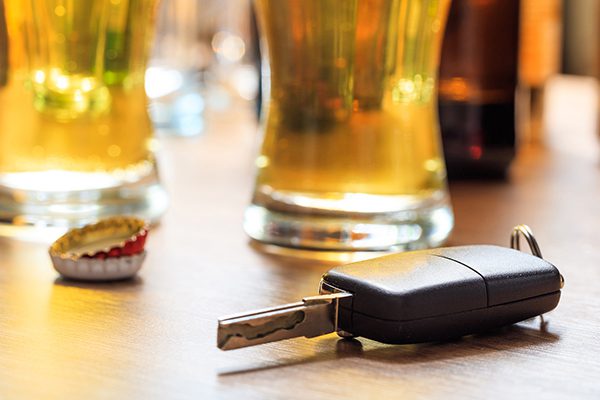Don’t drink and drive – surely by now everyone knows that driving under the influence of alcohol or drugs is dangerous. But people still do it, and the North Carolina Division of Motor Vehicles (DMV) has the stats to prove it.
Every year, the DMV compiles data on the state’s traffic crashes in its annual Traffic Crash Facts report. The 2020 report is 151 pages long and includes information on crash, injury, and death rates, city and county rankings, driver stats, and much more. Our firm has taken the report and summarized its main sections in an effort to communicate its key findings and make this valuable information easy to read. In this article, I dive deeper into the “The Impact of Alcohol and Drug Use on North Carolina Road Safety” section.
Alcohol-Related Fatalities Rise in 2020
In a year with 13% fewer car crashes and 14% fewer injury crashes than in the previous year, alcohol-related crashes and injuries remained relatively flat, but alcohol-related fatalities actually increased 18%. This alarming stat demonstrates the dangers of driving and drinking and reveal that alcohol use is resulting in more deadly crashes for North Carolinians.
Let’s be clear on the terminology:
- What is an alcohol-related crash?
Alcohol-related crashes are ones in which one or more of the drivers involved had a detectable blood alcohol concentration.
- What are alcohol-related fatalities and injuries?
Alcohol-related fatalities and injuries are people killed or injured in an accident in which one or more of the drivers involved had a detectable blood alcohol concentration.
- What does driving while impaired (DWI) mean?
If a 21 year old+ driver has a blood alcohol concentration (BAC) of .08% or higher, he or she is considered to be legally impaired in North Carolina.
The 2020 Traffic Crash Facts report revealed that more drivers with a BAC level of .08% or higher were involved in fatal crashes in 2020 than in the previous year.*
| DRIVERS IN FATAL CRASHES | |||
| BAC LEVEL | 2019 | 2020 | % change |
| .08-.14% | 78 | 88 | +13% |
| >.15% | 145 | 159 | +10% |
Teens, Alcohol, and Driving – A Deadly Combination
Even though teens were involved in fewer car crashes in 2020, almost three times as many NC teens (24) died in alcohol-related crashes than in the previous year. Further proof of the dangerous effect of alcohol and driving on the lives of teens is revealed with a glance at the increase in the number of alcohol-related teen accidents, injuries, and deaths as a percentage of total teen accidents, injuries, and deaths – these percentages even surpassed the five-year averages.
Greensboro and Durham Have High Alcohol-Related Crash Deaths
Perhaps not surprisingly, the largest cities in North Carolina experienced the most alcohol-related car crashes. Of the five most populated cities, Greensboro (3rd largest) and Durham (5th largest) had a disproportionate number of alcohol-related car crash deaths in the past two years. The chart below shows the five largest cities in the state and is ordered by population size, with the largest city listed first. In 2020, Greensboro and Durham outpaced their larger neighbor, Raleigh, in alcohol-related crash fatalities.
Alcohol-Related Crashes and Deaths in Five Largest NC Cities
| 2019 | 2020 | |||
| Crashes | Deaths | Crashes | Deaths | |
|---|---|---|---|---|
| Charlotte | 883 | 27 | 780 | 49 |
| Raleigh | 562 | 7 | 446 | 3 |
| Greensboro | 350 | 10 | 349 | 16 |
| Winston-Salem | 373 | 6 | 347 | 4 |
| Durham | 263 | 7 | 226 | 12 |
Source: North Carolina Traffic Crash Facts, 2019-2020
Driving While Impaired By Drugs on the Rise in NC
Among the 39 “contributing circumstances” to car crashes that the NCDOT tracks annually, there has been an alarming increase over the years in drug use. In 2020, drug use was the contributing factor that experienced the largest increase and was cited in 40% more crashes, 29% more fatal crashes, and 31% more injury crashes than the previous year.
In North Carolina, a person can be convicted of driving while impaired (DWI) if it can be proven that at least one of the following was consumed and caused impairment:
- A controlled substance, such as cocaine, marijuana, heroin, opioids, and some prescription drugs
- A psychoactive substance capable of impairing one’s physical or mental abilities
- A combination of these substances
Drug and Alcohol Use Remain a Troubling Problem on NC Roads
Despite some improvement, drug and alcohol use on NC roads remain an ongoing issue. It is clear that state officials should continue to drive home the message about the dangers of drug and alcohol use while driving to try to reduce crashes and fatalities on our roads. And it is each and every person’s responsibility to think twice before getting behind the wheel.
*The BAC data reflects the actual numbers taken from the DMV-349 crash report if a breath test is administered and the officer records the results or if the officer files a supplemental report for results obtained from lab blood testing.
You May Also Be Interested In
The Ultimate Guide to North Carolina DWI Law
How Many Beers Can You Drink in an Hour and Still Drive?
Driving Under the Influence: New Study Reveals Staggering Rates
Driving High: What Marijuana Car Accident Statistics Teach Us




